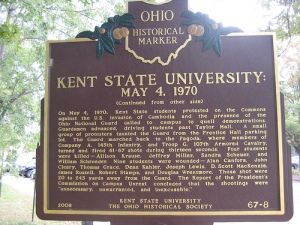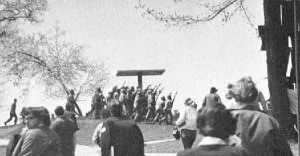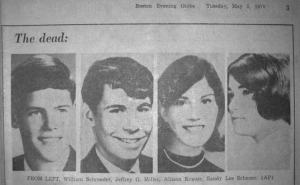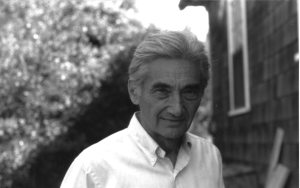Editor’s Note: Since January 1, 2010, we have been working on the Kent State Truth Tribunal, please go to www.TruthTribunal.org to learn more about our efforts to reveal the truth at Kent State in 2010. Thanks!
 On May 4, 2009 I participated in the 39th Annual Kent State University Memorial and gave this talk:
On May 4, 2009 I participated in the 39th Annual Kent State University Memorial and gave this talk:
My name is Laurie Krause. I am the sister of Allison Krause, the daughter of Arthur and Doris Krause.
I want to thank you for gathering together today. It’s an honor to be here at Kent State University to participate. I’d also like to thank the student body and May 4th Task Force for inviting me.
I am here to honor people who follow their truths, to respect people who live their ideals, and to focus on the healing of Kent State and our community at large.
39 years ago today, my sister, Allison Krause, was murdered by the Ohio National Guard for protesting and demonstrating against the Vietnam War. Also killed were Jeffrey, Sandra and William, and nine other Kent State students were seriously injured. I’m pleased to see a number of the surviving protesters here today, thank you for being here.
Allison was a freshman at Kent State who was incredibly passionate about life. She was a peace-loving, confident, altruistic, honor-student wanting to get the most out of college, and she was also deeply in love with her boyfriend, Barry.
As my older sister, Allison was someone I looked up to. She was so creative. I still look up to her and continue to be inspired that the whole world may be changed by any real person, like you or me, walking forward with hope and living our ideals and truths.
Let me ask you, today, are you living your truth?
Allison vehemently disagreed with the US government and its involvement in Vietnam so she assembled with many others and protested on Friday, the first of May, not knowing that she was putting her life in jeopardy, yet feeling strongly that the actions committed by our government were wrong.
On that day, a group of 500 students assembled to protest the US invasion of Cambodia. Rallies were planned for Monday to continue protesting the expansion of the Vietnam War.
The Ohio National Guard was sent in on Saturday and Kent State became a war zone overnight. Students were tear gassed and wounded by bayonets during demonstrations taking place over the weekend.
The ROTC building was burned down in retaliation for the students being attacked for expressing their right to protest and assemble.
Press conferences held by Gov. Rhodes called protesters un-American. Rhodes declared a state of emergency, banned any further demonstrations and imposed martial law at Kent. Curfews were set. Students had to run from Guardsmen on campus late at night and Allison ran from them that night. Students couldn’t return to their dorm rooms and were stuck wherever they could find shelter for the night.
Over the following days, the Kent State University campus ignited into one of our country’s worst nightmares.
As tensions heightened over the weekend, Allison called home to my parents to let them know what was happening on campus. My father told Allison to be cautious; he even asked her to back down and not involve herself.
My parents, like most parents, were coming from a place of love for their daughter. They wanted her to be safe.
But Allison was aware of the risks involved. Still, she never considered not protesting against something she was incredibly passionate about. The Vietnam War had just taken a turn for the worse, it was a time when hope for peace was fading.
To Allison, it was an obligation to show dissension to the government invading Cambodia. She made her decision, and we all know the outcome.
That Monday, despite school officials attempting to ban the demonstration by sending out leaflets, more than 2,000 people arrived to protest the government’s actions.
The dispel process began that morning with leaders telling student protestors to go home or be arrested. Students responded to these infringements of rights by throwing rocks. Wearing gas masks, the National Guard used tear gas to exert control over the growing crowds.
After some time with a lot of maneuvering Guardsmen turned in unison and took aim.
The shooting lasted 13 seconds.
Dumdum bullets were used – a type of bullet that’s illegal in warfare – and explodes on impact.
My sister died in Barry’s arms.
Allison’s death symbolizes the importance of our right to protest and speak our truths freely.
The day after the shooting, my father Arthur Krause spoke on television, telling the public how Allison’s death shall not be in vain.
Afterwards, my parents followed their truth through the legal system and in the courts over the next nine years. They sought the truth about Kent State and the reason for the murder of their daughter … going all the way to the US Supreme Court. Their final appeal was settled and the federal government issued a statement of regret.
It’s no secret that my family holds Nixon, Rhodes and the State of Ohio responsible.
Also, with the recently re-discovered audio tape, proof of an order to shoot has been found.
We now know that our government intentionally committed this deadly act against the youth of 1970, calling them ‘bums’ as they protested the Cambodian Invasion.
Triggers were not pulled accidentally at Kent State. What happened was malicious, what happened was irresponsible, what happened was evil.
The shooting was at best, without any forethought, and at worst, with total forethought. Firing on a group of unarmed students, who were simply exercising their First Amendment rights to express dissent with their government was a crime.
What do we do with an order to shoot? What can you do when the government gives permission to use ultimate force, to use deadly force, against its dissenters?
It was the government’s goal to make a defining statement and shut down student protest across the country that day…and they did…for years!
There is no such thing as a true democracy when this happens.
The local, state and federal governments never accepted responsibility for the murder of Allison, Jeffrey, Sandra and William and the injuries sustained by nine others that occurred 39 years ago today.
The people injured in the protests are reminded of it everyday.
The Kent State shooting has changed all of our lives forever, both on the inside and the outside. My family lost its eldest child and were robbed from seeing her blossom in her life past 19 years. I lost my only sister and I miss her each day.
Looking back, did the Kent State protest and killings make a difference?
Well, there was a huge response by Americans.
The Kent State shooting single-handedly created the only nationwide student strike with over 8 million students from high schools to universities speaking out and holding rallies afterward.
And Jackson State also culminated in murderous acts in a similar quest to silence student protest.
We became a nation at war with itself.
But how did we let it get that far? How did this happen?
People will never forget that day at Kent State. Today marks an event that still hits deep for so many of us.
People who were directly involved, people who believe in the Bill of Rights and the freedom to disagree with the government, people who continue to share a vision of harmony and peace for all. We’re all active participants; we are all involved in what happened.
Today is about remembrance, honor, respect and a focal point for a change in the way we handle dissension with governmental actions.
What have we learned? What can we take away from this horrible event?
For starters, we must each take responsibility for what happened so we may learn from the past, to learn from our mistakes.
First, I’m interested in learning more about the re-discovered audio recording from a student’s window ledge during the actual shooting. With new recording and audio technologies, we have revealed that ‘order to shoot.’
The order to shoot has always been a concern. In fact, each and every governmental or military official throughout the legal battle has stated under oath that there was never an order to shoot.
However, I do not accept their words and I ultimately believe they perjured themselves. There is no way the National Guard could march uphill away from the crowd – to turn in unison after reaching the top, and to shoot into the crowd – without premeditated forethought. Their bullets murdered students from over a football field away. There is no way this could ever be accomplished without an order to shoot. (Click to hear tape.)
Now with this re-discovered tape recording, we finally have proof that an order to shoot was given.
With this tape, it is very much my belief that until the truth is brought to light here, the Kent State Killings will continue to remain an ugly, unknown, unaccounted-for wound.
Case in point, just a little over a week ago Kent State students had another brush with aggressive police action during College Fest, a block party where 60 people were arrested and rubber bullets were shot into the crowd for ‘crowd control.’
People were shot for no reason, arrested for not disbanding, and fires started in the streets.
At an event with no political subtext, we can see how much kindling there already is, waiting for a spark to ignite an explosion of extreme violence. It’s still there!
We’re still seeing the same tension of the Kent State shooting that happened 39 years ago, today. The cause and effect is still active here at Kent State.
Unless we heal these wounds, they shall continue festering.
Instead of focusing on our differences, let’s focus on what brings us together.
Right now, at this point in time, it is critically important that we work together in harmony to benefit all.
We can’t perpetuate this us/them polarization of constant reaction to what’s happening around us anymore. I mean, how’s that working for us? Is that working?
So, how do you heal a community, a nation? Or should I ask, how do we heal ourselves?
Each day as we live our truths, our intentions capture a healing, beautiful, peaceful essence for positive change.
Despite harsh criticism by local residents, even by her own president, Allison and others continued on.
Allison believed in making a difference. Being anti-war and pro-peace and harmony, she was called to action. Although it was not her clear intention, Allison spoke, participated in and died for what she believed in.
The spirit of Allison asks “What are we but what we stand for?”
Don’t hope for a new tomorrow, live it today and live your truth each day. We all make a difference by speaking our truths against all odds.
Through-out my life I looked to my big sister for inspiration. Allison taught me the importance of living a life of intention and truth and I am now consciously and busily speaking my truths.
That is Allison’s message and it not just for me.
I want to close the speech by sharing with you how I have the spirit of Allison in my life as I live on the Northern California coast.
A few years ago under the Bush Administration, a major utility company and the federal government wanted to begin exploring wave energy renewable energy technologies in the Pacific Ocean near where I live.
As it progressed, the administration was very gung-ho on exploring wave technologies with a mentality of ‘throwing technology into the ocean and let’s see what happens!’
In March 2008, I marched for the Mendocino Wave Energy Moratorium, to be a voice for protecting the marine environment, to slow it down for proper environmental research to be conducted and to involve the community in this project.
In 2007 I also began publishing a blog called MendoCoastCurrent. I did this as my personal, political act and operate as the Wave Energy Blogger and an environmental activist now.
Allison showed me that it is my responsibility to live and speak my truth. If I do not agree with what’s happening, it is my right to protest, assemble and voice my concerns.
Since then I’ve encountered quite a few unforeseen obstacles and hostile harassment, yet I still believe that even in the face of opposing forces and arrest, I must fight my good fight…and keep on, keeping on! Allison whispers this in my ear.
Let’s stand up for what is right and best for all. We must protest against injustices and use our voices to speak out when we disagree with what’s happening.
On the Mendocino coast as all looked lost regarding the negative effects of wave energy with mounting environmental concerns regarding this nascent technology in our ocean, President Obama was inaugurated.
Obama and his administration bring us so much good news. They are approaching renewable energy technology from an environmentally-safe perspective along with incorporating community aims and input now. And that massive utility company is following suit.
Environmental concerns in creating safe renewable energy in my community may now be possible!
And I feel Allison smiling!
We must still remain ever vigilant yet I’ve found a great deal of hope and comfort in what I’ve seen these past one hundred days of Obama.
I’m hopeful that we may become more conscious of our use of our precious resources, in using and generating our electricity and in fueling our vehicles.
I’m hopeful that the truth about Kent State will someday be known.
As we learn to speak our truth, even in the face of danger and opposition, we bring change and harmony.
So I ask you…and I ask you for Allison as well…how are you speaking your truth today?
Read Full Post »
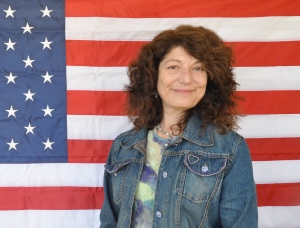 My sister Allison Krause was one of four students killed in the 1970 Kent State shootings. You may have heard about that day in American history – May 4, 1970 – when the Ohio National Guard opened fire on unarmed students protesting the invasion of Cambodia. Some of those killed or injured were just walking to class. After the guardsmen fired their weapons, four students lay dead, and nine others were wounded by gunfire. Forty years have passed and no one has ever been held accountable.
My sister Allison Krause was one of four students killed in the 1970 Kent State shootings. You may have heard about that day in American history – May 4, 1970 – when the Ohio National Guard opened fire on unarmed students protesting the invasion of Cambodia. Some of those killed or injured were just walking to class. After the guardsmen fired their weapons, four students lay dead, and nine others were wounded by gunfire. Forty years have passed and no one has ever been held accountable.

